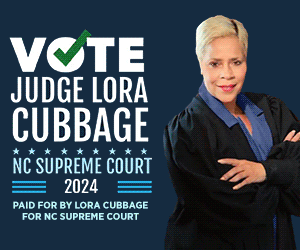Sit-in participants remember lunch counter integration
By Yasmine Regester, Staff Writer / July 28, 2017
Brenda Dalton James, Charles Bess, LaRue Moore, and Rosalyn Smith shared their experiences during the 1960s sit-ins at the 57th anniversary of the integration of F.W. Woolworth’s lunch counter. Photo by Charles Edgerton/Carolina Peacemaker
The Greensboro community gathered to celebrate and remember the courageous acts led by four A&T freshmen: Ezell Blair, Jr. (Jibreel Khazan), Franklin McCain, Joseph McNeil, and David Richmond, at the International Civil Rights Center and Museum on Tuesday.
July 25 marked the 57th anniversary of the integration of the F.W. Woolworth lunch counter, that is on display in the lower level of the museum.
These students began the lunch counter sit-ins at the Woolworth’s store on February 1, 1960 in downtown Greensboro. It took the dedication of the area’s college students, high school students, faith-based leaders, civic leaders, and community leaders to change the status quo.
After six months of a steady decline in sales, the Woolworth’s lunch counter finally opened to serve African Americans on July 25, 1960.
Charles Bess, a busboy at F.W. Woolworth’s at the time, became one of the first African Americans to eat at the newly integrated lunch counter. The manager, Clarence L. “Curley” Harris, invited the Black employees to be the first to eat at the counter.
“When those young men came in, all they wanted was a cup of coffee, and they were refused. I would have loved to have given them a cup of coffee, but I knew that would have meant my job,” said Bess.
The A&T Four sat down at the Whites only Woolworth’s lunch counter and refused to leave when denied service. They came everyday and stayed until the store closed, only to return the next day with more students that kept the lunch counter seats filled. That pivotal moment helped galvanize the Civil Rights Movement and lunch counter sit-ins across the United States.
The movement also led to the creation of the Student Non-Violent Coordinating Committee (SNCC) in April 1960, with help from civil rights pioneers, Ella Baker and Martin Luther King, Jr.
A&T and Bennett College students routinely met and collectively organized guidelines and training for picketing. Rosalyn Smith, a 1961 Bennett College grad and a sit-in participant said although there was fear, they knew they had to do something.
“We had meetings every night with the A&T students,” said Smith. “We had some fear, but we also felt we were invincible at the time.”
While the college students put the sit-in efforts in motion, it was the high school students and neighborhoods that helped keep the movement going when the majority of the college students went home for the summer.
Brenda Dalton James, who served as moderator for the event, was also a sit-in participant as a Dudley High School student.
“Greensboro was very segregated. There were very few stores that we could go in and those that we could had segregated areas where we could shop,” said James, who is also the 2017 ICRCM Sit-In Award recipient.
Although more and more restaurants in downtown Greensboro began to desegregate, it still took three more years before movie theaters, lodgings and other public facilities would begin to follow suit. From 1961-1963 students continue to organize mass demonstrations that produced some of the largest mass arrests of civil disobedience in the South.
LaRue Moore was a high school student at the time who worked at her parents barbecue restaurant, Martel’s Bar-B-Q owned by John and May Marx off of old Burlington Rd. Moore noted their restaurant catered to mostly Whites and her parents were fearful of what would happen to their business if they integrated.
At the behest of a prominent community leader, Dr. George Simkins, Moore’s parents opened up their restaurant to everyone. Business did suffer, however, the restaurant was subsequently given a contract by the Greensboro NAACP to provide meals to the makeshift jail where the demonstrators were being held.
“It was a tremendous thing we were doing,” said Moore who also spoke of the weeks of training they had to undergo in order to protest. “They told us not to be looking around at people, don’t be talking or playing around with your friends. You needed to be focused and serious.”
She added, “I believe that our challenge now is for us to reach back to the youth and show them that they too have something to stand up for.”







